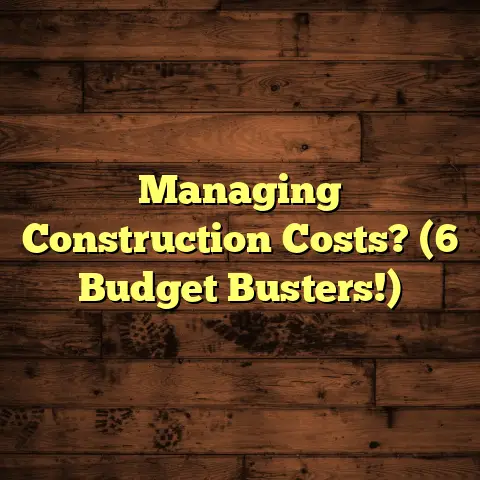Best Wood Floors? (Top 3 Install Disasters!)
I’m your friendly neighborhood flooring contractor, and I’m excited to talk about something near and dear to my heart: wood floors.
Over the years, I’ve seen some incredible advancements in wood flooring technology. It’s not just about planks of wood anymore.
Manufacturers are constantly pushing the boundaries, embracing new techniques and materials to create floors that are not only stunning but also incredibly durable and sustainable.
Think about it – we now have engineered wood that resists moisture like a champ, finishes that can withstand the daily onslaught of kids and pets, and eco-friendly sourcing practices that make you feel good about your choices.
Wood flooring has always been a favorite among homeowners and designers alike. Why? Because it’s timeless. It effortlessly complements any interior style, from rustic farmhouse to sleek modern.
But here’s the thing: even the most innovative, high-quality wood flooring can turn into a nightmare if it’s not installed correctly. Trust me, I’ve seen it all!
That’s why I’m here to share my insights on the top three wood floor installation disasters I’ve encountered over the years. We’ll dive into what causes them, how to prevent them, and what to do if you find yourself in the middle of one.
So, grab a cup of coffee, settle in, and let’s get floored by the realities of wood floor installation!
Section 1: The Allure of Wood Flooring
Why do we love wood floors so much? It’s more than just aesthetics. Wood floors bring a certain warmth and richness to a home that’s hard to replicate. They’re inviting, comforting, and add a touch of elegance to any space.
Plus, they’re built to last. A well-maintained wood floor can easily last for decades, becoming a part of your home’s history. And let’s not forget the value they add to your property. Potential buyers love the look and feel of real wood.
Now, when we talk about wood flooring, we’re not just talking about one thing. There’s a whole world of options out there, each with its own unique benefits:
- Solid Hardwood: The classic choice. These are planks made from a single piece of wood. They’re incredibly durable and can be refinished multiple times.
- Engineered Wood: Made from layers of wood with a hardwood veneer on top. It’s more resistant to moisture and temperature changes than solid hardwood.
- Laminate: A synthetic material designed to mimic the look of wood. It’s budget-friendly and easy to install.
- Luxury Vinyl: Another synthetic option that’s waterproof and highly durable. It’s a great choice for bathrooms and kitchens.
According to a recent survey by the National Wood Flooring Association (NWFA), wood flooring remains a top choice for homeowners.
In fact, 75% of homeowners said they would choose wood flooring for their next project, citing its durability, beauty, and ease of maintenance as key factors.
But with all these options, it’s easy to get overwhelmed. That’s why it’s so important to do your research and choose the right type of wood flooring for your needs and lifestyle.
Section 2: The Importance of Proper Installation
Okay, so you’ve chosen the perfect wood flooring for your home. Congratulations! But the journey doesn’t end there. In fact, it’s just beginning.
Proper installation is absolutely crucial when it comes to wood flooring. I can’t stress this enough. Even the highest-quality materials will fail if they’re not installed correctly.
I’ve seen some real horror stories over the years, all stemming from poor installation techniques.
Common pitfalls include:
- Inadequate Preparation of the Subfloor: A level, clean, and dry subfloor is essential for a successful installation.
- Improper Acclimatization of the Wood: Wood needs time to adjust to the humidity and temperature of your home before installation.
- Lack of Experience Among Installers: Wood flooring installation is a skilled trade. Don’t trust it to just anyone.
There are several standard installation methods, each with its own set of tools and techniques:
- Nail-Down: This method is typically used for solid hardwood floors.
- Glue-Down: This is a common method for engineered wood and parquet floors.
- Floating: This method is often used for laminate and some engineered wood floors.
- Click-Lock: A popular method for DIYers, this involves interlocking planks together.
Each method requires specific tools and expertise. Trying to cut corners or DIY without the proper knowledge can lead to costly mistakes.
That’s where professional installation comes in. A qualified flooring contractor will have the experience, knowledge, and tools to ensure a successful installation. They’ll also be able to identify and address any potential problems before they become major issues.
According to HomeAdvisor, the average cost of professional wood floor installation ranges from $6 to $12 per square foot.
While this may seem like a significant investment, it’s worth it in the long run. Professional installation can help you avoid costly repairs, replacements, and headaches down the road.
Section 3: Top 3 Install Disasters
Alright, let’s get to the juicy stuff. I’m going to share with you the top three wood floor installation disasters I’ve witnessed firsthand. These are the kinds of things that can make even the most seasoned flooring contractor cringe.
Disaster #1: The Buckling Blunder
Imagine this: you’ve just had your beautiful new hardwood floors installed. You’re thrilled! But a few weeks later, you start to notice something strange. The boards are starting to buckle and warp. What happened?
The culprit is likely improper acclimatization of the wood. Wood is a natural material, and it expands and contracts with changes in humidity and temperature. If you install wood flooring without allowing it to adjust to the environment of your home, it’s going to cause problems.
Here’s the science behind it: when wood absorbs moisture, it expands. When it loses moisture, it contracts. If the wood is installed too tightly, it won’t have room to expand, and it will buckle under the pressure.
I remember one case where a homeowner in Denver, CO, insisted on having their hardwood floors installed immediately after delivery. The wood had been stored in a cold warehouse, and it hadn’t had time to adjust to the dry climate of the home.
Within a few weeks, the floors started to buckle so badly that you could trip over them. The homeowner had to pay thousands of dollars to have the floors removed and replaced.
According to the NWFA, proper acclimatization can prevent up to 80% of wood flooring problems.
So, how do you avoid the buckling blunder? It’s simple: allow the wood to acclimatize to your home for at least three to five days before installation. This means storing the wood in the room where it will be installed, allowing it to adjust to the temperature and humidity levels.
Disaster #2: The Gapping Gap
Picture this: you’re walking across your new wood floors, and you notice something unsettling. There are gaps between the boards. Not just tiny little cracks, but noticeable gaps that catch your eye.
This is a classic case of poor installation techniques. Gapping can occur for a variety of reasons, including:
- Improper Spacing: Wood floors need room to expand and contract. If the boards are installed too tightly together, they’ll push against each other and create gaps.
- Inadequate Subfloor Preparation: An uneven subfloor can cause the boards to shift and create gaps.
- Using the Wrong Fasteners: The wrong nails or screws can cause the boards to loosen and create gaps.
Gapping isn’t just an aesthetic issue. It can also lead to functional problems. Gaps can allow drafts to enter your home, increasing your energy bills. They can also trap debris and moisture, leading to mold and mildew growth.
I once worked on a project where the installer had used the wrong type of nails to install the hardwood floors. Within a few months, the nails started to loosen, and the boards began to separate, creating unsightly gaps.
The homeowner was furious. Not only did the gaps look terrible, but they were also letting in cold air during the winter. The cost to repair the damage was significant.
To prevent the gapping gap, it’s essential to use proper installation techniques. This includes:
- Leaving Adequate Spacing Between Boards: Consult the manufacturer’s instructions for the recommended spacing.
- Preparing the Subfloor Properly: Ensure that the subfloor is level, clean, and dry.
- Using the Right Fasteners: Use the type of nails or screws recommended by the manufacturer.
Disaster #3: The Cupping Catastrophe
Imagine this: you’re admiring your new wood floors when you notice something peculiar. The edges of the boards are starting to rise, creating a cupped appearance. It’s like the boards are trying to curl up at the edges.
This is a telltale sign of cupping, a common problem caused by improper moisture management. Cupping occurs when the bottom of the wood boards absorbs more moisture than the top. This causes the bottom to expand more than the top, resulting in the edges rising.
The causes of cupping can include:
- High Humidity Levels: Excessive humidity can cause the wood to absorb moisture from the air.
- Water Damage: Leaks, spills, or flooding can saturate the wood and cause it to cup.
- Inadequate Ventilation: Poor ventilation can trap moisture under the floor, leading to cupping.
I remember one case where a homeowner in Miami, FL, had installed hardwood floors in their bathroom. The bathroom was poorly ventilated, and the humidity levels were consistently high.
Within a few months, the floors started to cup so badly that it was uncomfortable to walk on them. The homeowner had to replace the entire floor.
According to the Institute of Inspection, Cleaning and Restoration Certification (IICRC), cupping can reduce the lifespan of wood flooring by as much as 50%.
To prevent the cupping catastrophe, it’s essential to manage moisture levels in your home. This includes:
- Maintaining Proper Humidity Levels: Use a dehumidifier to keep humidity levels between 30% and 50%.
- Addressing Water Leaks Promptly: Repair any leaks or spills immediately.
- Ensuring Adequate Ventilation: Make sure your home is properly ventilated, especially in bathrooms and kitchens.
Conclusion
So, there you have it – the top three wood floor installation disasters I’ve encountered over the years. Buckling, gapping, and cupping are all common problems that can be avoided with proper planning, preparation, and installation techniques.
As we’ve discussed, innovation in wood flooring is constantly evolving. Manufacturers are creating new materials and finishes that are more durable, sustainable, and beautiful than ever before.
But even the most advanced wood flooring can fail if it’s not installed correctly. That’s why it’s so important to choose a qualified flooring contractor who has the experience and expertise to do the job right.
When choosing wood flooring for your home, consider the following:
- Your Lifestyle: Do you have kids or pets? Choose a durable, scratch-resistant flooring option.
- Your Budget: Wood flooring can range in price from affordable to luxurious. Set a budget and stick to it.
- Your Style: Choose a wood flooring that complements your home’s décor.
Remember, well-installed wood floors can add beauty, value, and warmth to any space. By making informed decisions and working with qualified professionals, you can ensure a successful flooring project that you’ll enjoy for years to come.
Call to Action
Now, I’d love to hear from you! Have you had any experiences with wood flooring, good or bad? Share your stories in the comments section below.
And if you’re planning a wood flooring project, don’t hesitate to connect with flooring professionals in your area. They can help you choose the right materials, install your floors properly, and avoid potential disasters.





